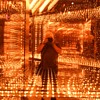Posted 9 years ago
 rniederman
rniederman
(346 items)
Long before radio, television and social media (etc.), photography was an early form of entertainment. Stereo photography, in particular, was very exciting. Ironically, the concept of viewing images in 3D predates photography by a year or so. In 1838, Sir Charles Wheatstone described a concept to look at stereoscopic drawings using his own invention of a mirror (reflecting) stereoscope. However making drawings was difficult but photography, a new invention of the time, proved to be an ideal way to easily produce stereo image pairs. All that was needed was a camera that could shoot two dissimilar pictures of the same subject at slightly different angles.
In 1841, Henry Fox Talbot and Henry Collen were creating stereoscopic daguerreotypes for Wheatstone’s stereoscope. Unfortunately, the device used mirrors, was rather large and not very easy to use. An improved optical viewer that visually merged image pairs and a “binocular camera” to produce stereoscopic pictures was invented by Sir David Brewster in 1849. The camera’s first use was to reproduce objects of art for his stereoscope. Brewster’s early stereoscopes were smaller solid-bodied, tapered wooden boxes.
Small, portable viewers appeared in 1853 when John Mascher, a Philadelphia inventor, added a flap with a pair of magnifying lenses to an ordinary daguerreotype case. These early “Mascher” style viewing cases became quite popular for a brief period from 1853 to 1856.
Shown here is an exceptional example of another style of daguerreotype viewing case invented and patented in 1855 by John Stull of Philadelphia. Unlike the other forms, it collapses rather than folds. Stull’s design also had an advantage of using a combination of hinges to keep the lenses parallel to the image and ‘focus’ by changing the lens-to-image distance. An early advertising broadside for Stull’s North American Gallery mentions having:
“... beautiful Boxes, with a Stereoscope attached in the lid, a very ingenious and novel contrivance for showing likenesses, paper or glass views. The portraits of a whole family may be kept and shown through the same Stereoscope, which, when closed, resembles a lady’s workbox; a beautiful ornament for the centre table, and very entertaining.”
Stull also sold a plain viewer, but it’s this magnificent green leather version with extraordinary gold imprinting of an American eagle surrounded by graceful floral graphics and patentee information on the front and back that makes it an important piece of Americana. This ornate viewer is very rare with only five examples known, and an important part of my collection.





































![Thornton-Pickard Wood Shutters and Congo (x5) [2410-C5B]](https://i.ebayimg.com/images/g/w20AAOSwDg1nMW5k/s-l225.jpg)

Another A+ item.
A beauty too!
GREAT early stereo and case!
scott
Amazing!
very very beautiful!!!
Thanks!
fortapache
pw-collectorpw
ho2cultchaho2
kyratango
Scott
Thanks!
Ben
Manikin
David
John
Thanks!
Sean
vetraio50
Michael
Great condition item, very rare to find like that, beautiful.
Alan
Thanks!
sugargirl
racer4four
blunderbuss2
Hunter
Thanks!
Alan2310
Roycroftbooksfromme1
Thanks!
trunkman
bobby725
SpiritBear
Lovely purchase. Beautiful case.
Absolutely incredible!!!
Thanks, Radegunder!
Thanks, verbatim!
Thanks!
liventruth
jscott0363
Thanks!
antiquerose
ho2cultcha
Thanks!
Nicefice
LOUMANAL
Thanks!
ravage60
VintageArgentina
Thanks, pops52!
Thanks!
toolate2
Oroyoroyisthatyourhorse
Thanks, Nursekent!
Thanks, Thomas!
Thanks!
AnnaB
dlpetersen
Thanks!
Johnsmith
antiquerose